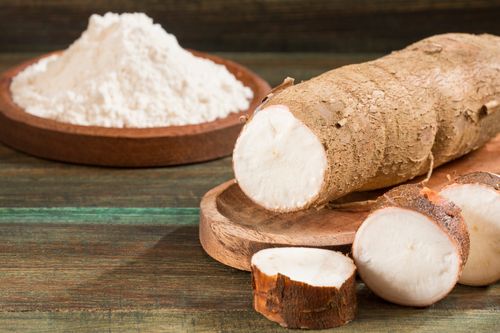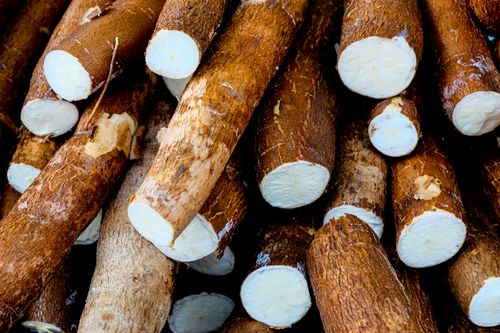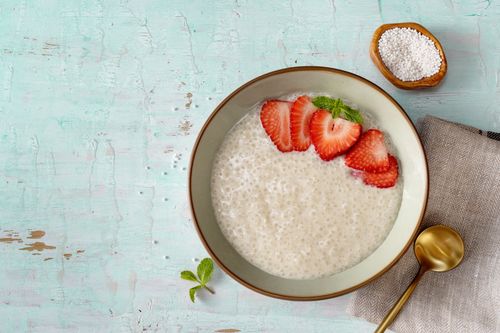
Tapioca: Introduction
Tapioca is neither a fruit nor a vegetable. It is a starchy substance derived from the roots of the cassava plant. This plant goes by the name of manioc, yuca, and Manihot as well. Brazil and much of South America are home to these shrubs. Though cassava roots are edible in their boiled form, a significant amount of the plant is extracted for its starch.
Tapioca starch and tapioca flour are the same. It is a staple food item in India and other tropical areas. Tapioca is a rich source of carbohydrates. Tapioca has a neutral flavor and strong gelling power, making it effective as a thickening agent in both sweet and savory foods. The consistency of cooked tapioca is thick and sticky. It has a texture similar to that of corn starch.
Production of Tapioca from Cassava Roots
Cassava roots contain linamarin, a compound that can convert into cyanide. Treating cassava roots to remove this compound gives tapioca as a by-product. The cassava root is picked, cleaned, and crushed into a pulp in a mill. The pulp is then squeezed dry, leaving fine-grained tapioca starch behind.
Nutritional values of Tapioca
One serving of dried tapioca (152 g) pearls has:
- 544 – calories
- 135g – Carbohydrates
- 0 g – Protein
- 0 g – Fat
Tapioca is purely made of starch. This explains its high carbohydrate content. It contains a negligible amount of protein and fat. The vitamin and mineral profiles are almost insignificant in terms of daily recommended values.
Tapioca is often considered a source of empty calories. It is mainly due to its calorie-dense nature and low nutritive values. However, the rich carbohydrate source works as an effective energy booster.
In Indian cooking, vegetables, nuts, and milk are added to tapioca dishes to increase their nutritive values. Since tapioca is cooling for the body, it is often eaten as a breakfast item in the summers.
During the partition of India, the refugees would stock up on tapioca, also called sabudana. It was due to its convenience and high-calorie value. It also happens to be pocket-friendly. Despite its reference to a ‘poor man’s food’, tapioca is a staple in almost all Indian households.
Forms of Tapioca
Tapioca is manufactured in many forms for commercial use. Soluble starch powder, flakes, rectangular sticks, and pearls are the most common of them. The tapioca flakes, pearls, and sticks need sufficient soaking before cooking them. This helps them to rehydrate. They become up to double their volume upon rehydration. The tapioca products gain a swollen look with a leathery texture in their cooked state.
Tapioca pearls are spherical starch balls that come in different sizes. Though they are generally white, the pearls can be dyed. They lose their opaqueness after heating and become transparent. Boba are large sweetened tapioca pearls often dyed black and used for bubble tea.
Tapioca: Usages
Tapioca finds its use in many genres of cooking.
- The parent cassava root is a substitute for potatoes, owing to its mild taste.
- Casabe is a type of flatbread that uses tapioca as its ingredient. It tastes great on its own as well, along with other dishes.
- Tapioca flour is useful in making gluten-free and grain-free bread.
- Tapioca pearls are a great addition to desserts. You can make puddings, kheer, and bubble teas with them.
- Use tapioca flour as a thickening agent in soups and gravies. It does its job without altering the taste of the original dish.
- Tapioca is perfect for dishes that require extra moisture. You can mix tapioca in doughs and burger patties to improve moisture content and texture .
- Tapioca starch is an alternative to cornstarch in a 1:1 ratio.
Health Benefits of Tapioca
When prepared and consumed properly, tapioca has numerous benefits. Some of them are discussed below.
1. Helps in a healthy weight gain
Tapioca is a simple and nutritious way to gain weight. Due to its large carbohydrate content, it is an easy way to increase your daily calories. Tapioca is also cholesterol-free. However, sucrose forms the bulk of the sugars in cassava roots and should not be consumed in large quantities
2. Helps in boosting blood circulation
Tapioca has a small amount of iron and copper. These minerals are important for blood health. With good circulation and adequate oxygen, these minerals fight diseases like anaemia.
3. Could help in minimizing birth defects
Tapioca may be high in B-complex vitamins. When consumed during pregnancy, they’ve been linked to a lower risk of neural tube defects in babies.
4. Aids digestion
Dietary fibre abounds in tapioca. Constipation, bloating, and digestive pain are all reduced by fibre.
5. Strengthens bone mineral density
This tuber is high in protein and Vitamin K. They are beneficial to muscle and bone health. Hence, they can make your limbs and joints healthy, supple, and flexible.
6. Potential to prevent Alzheimer’s
According to a study, vitamin K is also beneficial to mental health. The incidence of Alzheimer’s disease is reduced by increasing brain neuronal activity.
7. Salt and trans-fat free
Tapioca is safe to eat if you have high blood pressure, since its sodium content is low. It contains no added sugars or cholesterol. It’s a gluten-free alternative to use in cooking and baking.
8. Prevents heart issues
Tapioca provides several heart-health benefits, including the prevention of heart disease and stroke. People with hypertension benefit the most from it since its low sodium content.
9. Aids in osteoporosis prevention
A significant level of calcium is beneficial for osteoporosis prevention. With sufficient tapioca consumption, bones will become stronger.
Skin and Hair Benefits of Tapioca:
- Brightens Your Face
- Can be used as a face mask
- Hydrates your skin
- Aids Hair Growth
- Controls Hair Fall
- Nourishes Hair
Recipes using Tapioca
1. Tapioca Pudding
This pudding is a mouth-watering dessert and comfort food for many.
Ingredients needed:
- Tapioca pearl (small size)- ½ cup
- Cow milk or any plant milk – 3 cups
- Salt – ¼ teaspoon
- Eggs – 2
- Maple syrup or honey – 1/3 cup
- Vanilla extract- 1 teaspoon
Method:
- Soak the tapioca pearls into 2 cups of water for 2-3 hours.
- Combine the milk, salt and tapioca pearls in a pan. Cook them on low heat.
- The pearls are fully cooked when they have doubled in size and have a translucent texture.
- Stir occasionally to avoid the pearls from sticking to the bottom.
- Take a separate bowl and beat the eggs in them.
- Slowly add some of the hot tapioca mixtures to the egg bowl. This is to ensure that the mixture does not curdle due to the varying temperatures.
- Now add the egg mixture to the remaining tapioca in the pan.
- Stir for a couple of minutes on medium heat. Do not let the tapioca pearls boil.
- Once you achieve the pudding consistency, rest the mixture for 20 minutes.
- Add in the honey and vanilla extract.
- Serve hot or chilled as per preference.
2. Bubble tea
Commercially, bubble tea has a massive fan base. This recipe shows you how to make them at home for a serving of 4.
Ingredients:
- Black tea bags- 8
- Tapioca pearls- ¾ cup
- Water- 4 ½ cups
- Sugar- ½ cup
- Milk – As per your preference
Method:
- First, create a simple syrup. For this, add ½ cup of water and sugar to the pan.
- Heat the pan until all the sugar has dissolved.
- Remove the pan from the stove and let it rest.
- To make the tea, steep the tea bags in 4 cups of water.
- Check the tapioca packet for soaking instructions. Follow it accordingly.
- Cook the tapioca pearl in about 4 cups of boiling water.
- Transfer the cooked pearls to a bowl and rinse them with regular water.
- Mix the pearls with a few tablespoons of simple syrup.
- Divide the pearls into 4 glasses. Add in ice cubes.
- Strain 1 cup of tea into each glass.
- Add about 2 tablespoons of milk and simple syrup to it.
- Change the ratio of milk and simple syrup according to your preference.
- Serve with large boba straws or spoons.
Conclusion
Tapioca is a product of the cassava roots. The pearl form of tapioca is most common among the flour, flakes and sticks. It is a rich source of carbohydrates as well as calories. The other nutrient contents are very minor in quantity. Though it does not have an attractive nutrient profile, it has a significant amount of health benefits.
Since it is a root-based flour, it is an excellent option for gluten-free diets. Moreover, tapioca is a good addition to sweet dishes and bread. It is useful as a substitute for potatoes and corn starch.
It is a nutritious option for those who are trying to gain weight. However, diabetic patients should consult a doctor before consuming them. Add tapioca to your diet in moderation to reap its benefits.
Frequently Asked Questions
A. Tapioca has a wide range of health benefits. It can be used as a substitute for flour in gluten-free baking. It contains calcium, which is great for keeping brittle bones at bay, a huge problem for postmenopausal women. Tapioca also has iron, a vital mineral for people of all ages. It has a negligible saturated fat content and is great for overall cardiovascular health. It also serves as a great alternative for people suffering from celiac and irritable bowel disease. In general, tapioca contains low nutritional value compared to other grains.
Q. Is tapioca fattening?
A. Tapioca contains no saturated fats or cholesterol. It is a good alternative for those looking to avoid foods with saturated fats. Due to its high carbohydrate content, it can lead to weight loss.
A. Tapioca is arguably one of the best gluten-free substitutes to wheat flour. Tapioca can roughly substitute wheat flour into a 1:1 ratio. Cakes and cookies need finer granules and if you’re looking to thicken something like soup, a little of the coarser stuff will suffice.
A. Tapioca is made from cassava root. Consuming poorly prepared cassava root can sometimes lead to cyanide poisoning. However, due to its overall low nutritional content and high calorific value, it can be avoided by people with type 2 diabetes or obesity.
A. Moderate consumption of tapioca is safe. But it is mainly seen as a constituent of the popular boba tea, which can often be consumed in large amounts in short spans of time. This can lead to the starch lumps congealing together in the digestive tract. This can result in abdominal pain, constipation and, in some cases, require medical attention too.









